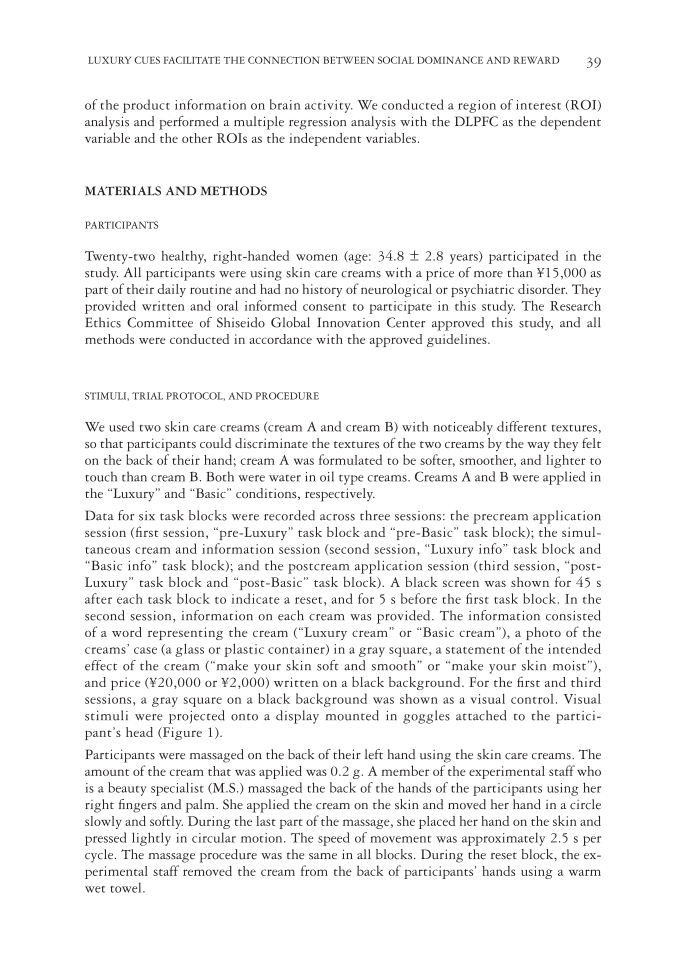LUXURY CUES FACILITATE THE CONNECTION BETWEEN SOCIAL DOMINANCE AND REWARD 39 of the product information on brain activity. We conducted a region of interest (ROI) analysis and performed a multiple regression analysis with the DLPFC as the dependent variable and the other ROIs as the independent variables. MATERIALS AND METHODS PARTICIPANTS Twenty-two healthy, right-handed women (age: 34.8 ± 2.8 years) participated in the study. All participants were using skin care creams with a price of more than ¥15,000 as part of their daily routine and had no history of neurological or psychiatric disorder. They provided written and oral informed consent to participate in this study. The Research Ethics Committee of Shiseido Global Innovation Center approved this study, and all methods were conducted in accordance with the approved guidelines. ST IMULI, TRIAL PROTOCOL, AND PROCEDURE We used two skin care creams (cream A and cream B) with noticeably different textures, so that participants could discriminate the textures of the two creams by the way they felt on the back of their hand cream A was formulated to be softer, smoother, and lighter to touch than cream B. Both were water in oil type creams. Creams A and B were applied in the “Luxury” and “Basic” conditions, respectively. Da ta for six task blocks were recorded across three sessions: the precream application session (fi rst session, “pre-Luxury” task block and “pre-Basic” task block) the simul- taneous cream and information session (second session, “Luxury info” task block and “Basic info” task block) and the postcream application session (third session, “post- Luxury” task block and “post-Basic” task block). A black screen was shown for 45 s after each task block to indicate a reset, and for 5 s before the fi rst task block. In the second session, information on each cream was provided. The information consisted of a word representing the cream (“Luxury cream” or “Basic cream”), a photo of the creams’ case (a glass or plastic container) in a gray square, a statement of the intended effect of the cream (“make your skin soft and smooth” or “make your skin moist”), and price (¥20,000 or ¥2,000) written on a black background. For the fi rst and third sessions, a gray square on a black background was shown as a visual control. Visual stimuli were projected onto a display mounted in goggles attached to the partici- pant’s head (Figure 1). Part icipants were massaged on the back of their left hand using the skin care creams. The amount of the cream that was applied was 0.2 g. A member of the experimental staff who is a beauty specialist (M.S.) massaged the back of the hands of the participants using her right fi ngers and palm. She applied the cream on the skin and moved her hand in a circle slowly and softly. During the last part of the massage, she placed her hand on the skin and pressed lightly in circular motion. The speed of movement was approximately 2.5 s per cycle. The massage procedure was the same in all blocks. During the reset block, the ex- perimental staff removed the cream from the back of participants’ hands using a warm wet towel.
JOURNAL OF COSMETIC SCIENCE 40 FMRI DATA ANALYSIS Scan ning was conducted using a 3.0T MRI system (Achieva Series Quasar Dual 3.0T Philips Medical Systems, Best, Netherlands). Blood Oxygenation Level Dependent T2- weighted MR signals were measured with a gradient echo-planar imaging (EPI) sequence [repetition time (TR) = 2,500 ms, echo time (TE) = 35 ms, fl ip angle (FA) = 90°, fi eld of view (FOV) = 230 × 230 mm2, scan matrix = 128 × 128, total scan time = 635 s, dynamic scans = 245 volumes, slice thickness = 5 mm, and 24 slices per volume]. Image process- ing was conducted with Statistical Parametric Mapping software (SPM12, Wellcome Figure 1. The three sessions of the study. In the second session, participants were given the product informa- tion visually during the massage. In the fi rst and third sessions, participants were given the same view without the product information.
Purchased for the exclusive use of nofirst nolast (unknown) From: SCC Media Library & Resource Center (library.scconline.org)


























































